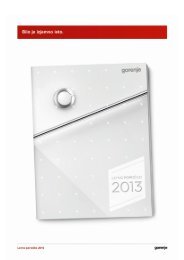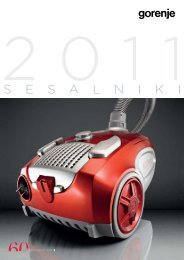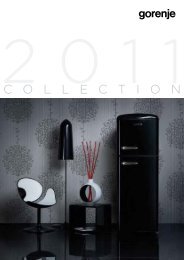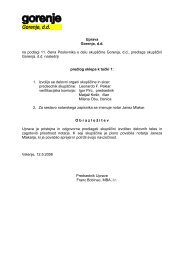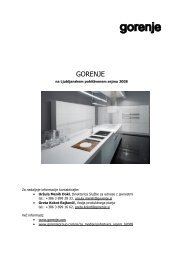ANNUAL REPORT 2008 - Gorenje Group
ANNUAL REPORT 2008 - Gorenje Group
ANNUAL REPORT 2008 - Gorenje Group
You also want an ePaper? Increase the reach of your titles
YUMPU automatically turns print PDFs into web optimized ePapers that Google loves.
90<br />
<strong>2008</strong><br />
or services or for administrative purposes. Investment property is measured at fair value (see note<br />
4(iii)) with any change therein recognised in profit or loss.<br />
When the use of a property changes such that it is reclassified as property, plant and equipment,<br />
its fair value at the date of reclassification becomes its cost for subsequent accounting of depreciation.<br />
(g) Leased assets<br />
Leases in terms of which the <strong>Group</strong> assumes substantially all the risks and rewards of ownership<br />
are classified as finance leases. Upon initial recognition the leased asset is measured at an amount<br />
equal to the lower of its fair value and the present value of the minimum lease payments. Subsequent<br />
to initial recognition, the asset is accounted for in accordance with the accounting policy applicable<br />
to that asset.<br />
Other leases are operating leases. The leased assets are not recognised on the <strong>Group</strong>’s balance<br />
sheet.<br />
(h) Inventories<br />
Inventories are measured at the lower of cost and net realisable value. The cost of inventories is<br />
based on the first-in first-out principle, and includes expenditure incurred in acquiring the inventories,<br />
production or conversion costs and other costs incurred in bringing them to their existing location<br />
and condition. In the case of manufactured inventories and work in progress, cost includes<br />
an appropriate share of production overheads based on normal operating capacity.<br />
Net realisable value is the estimated selling price in the ordinary course of business, less the estimated<br />
costs of completion and selling expenses.<br />
(i) Impairment<br />
(i) Financial assets<br />
A financial asset is assessed at each reporting date to determine whether there is any objective evidence<br />
that it is impaired. A financial asset is considered to be impaired if objective evidence indicates<br />
that one or more events have had a negative effect on the estimated future cash flows of that<br />
asset.<br />
An impairment loss in respect of a financial asset measured at amortised cost is calculated as the<br />
difference between its carrying amount, and the present value of the estimated future cash flows<br />
discounted at the original effective interest rate. An impairment loss in respect of an available-forsale<br />
financial asset is calculated by reference to its fair value.<br />
Individually significant financial assets are tested for impairment on an individual basis. The remaining<br />
financial assets are assessed collectively in groups that share similar credit risk characteristics.<br />
All impairment losses are recognised in profit or loss. Any cumulative loss in respect of an availablefor-sale<br />
financial asset recognised previously in equity is transferred to profit or loss.<br />
An impairment loss is reversed if the reversal can be related objectively to an event occurring after<br />
the impairment loss was recognised. For financial assets measured at amortised cost and availablefor-sale<br />
financial assets that are debt securities, the reversal is recognised in profit or loss.<br />
(ii) Non-financial assets<br />
The carrying amounts of the <strong>Group</strong>’s non-financial assets, other than investment property, inventories<br />
and deferred tax assets, are reviewed at each reporting date to determine whether there is<br />
any indication of impairment. If any such indication exists, then the asset’s recoverable amount is<br />
estimated. For goodwill and intangible assets that have indefinite lives or that are not yet availa-



